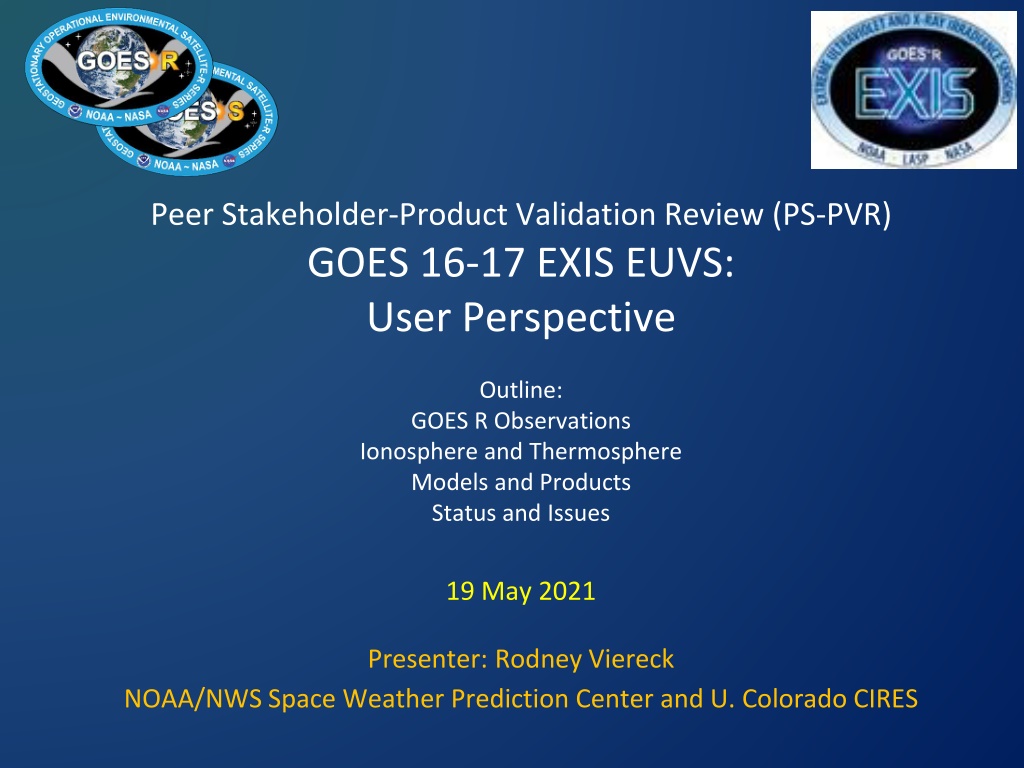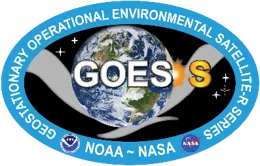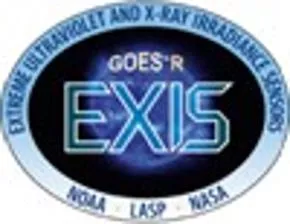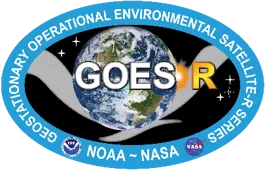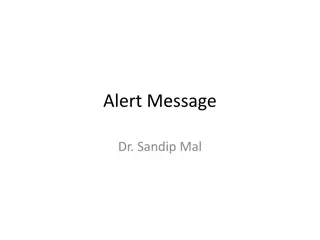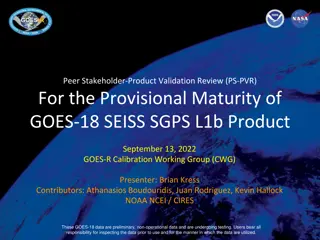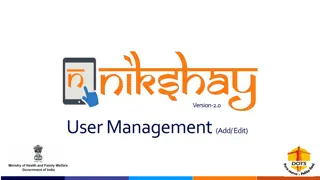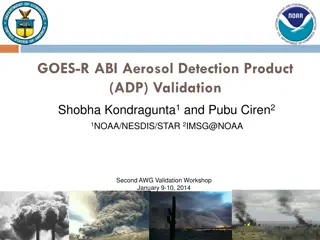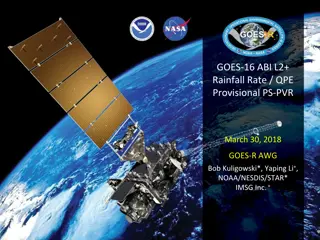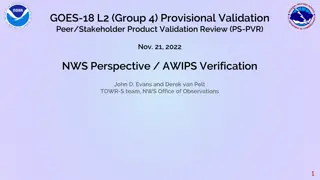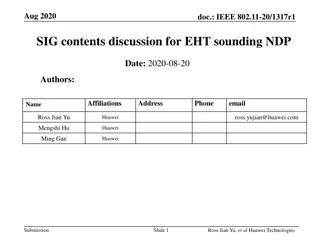GOES 16-17 EXIS EUVS: User Perspective
This presentation reviews the status and issues related to GOES R observations of the ionosphere and thermosphere models as of May 19, 2021. It covers the EUV spectrum, key spectral lines measured by GOES 16 EXIS EUVS, solar spectrum resolution requirements, solar energy deposition into the upper atmosphere, solar variability impacts on the upper atmosphere, and satellite drag calculations based on solar variability. The presenter, Rodney Viereck from NOAA/NWS Space Weather Prediction Center and U. Colorado CIRES, provides insights into the measurements and products utilized in the spectral models.
Download Presentation

Please find below an Image/Link to download the presentation.
The content on the website is provided AS IS for your information and personal use only. It may not be sold, licensed, or shared on other websites without obtaining consent from the author.If you encounter any issues during the download, it is possible that the publisher has removed the file from their server.
You are allowed to download the files provided on this website for personal or commercial use, subject to the condition that they are used lawfully. All files are the property of their respective owners.
The content on the website is provided AS IS for your information and personal use only. It may not be sold, licensed, or shared on other websites without obtaining consent from the author.
E N D
Presentation Transcript
Peer Stakeholder-Product Validation Review (PS-PVR) GOES 16-17 EXIS EUVS: User Perspective Outline: GOES R Observations Ionosphere and Thermosphere Models and Products Status and Issues 19 May 2021 Presenter: Rodney Viereck NOAA/NWS Space Weather Prediction Center and U. Colorado CIRES
The EUV Spectrum and GOES R Observations EUVS C Thousands of spectral lines span orders of magnitude in brightness EUVS A EUVS B Difficult to measure Too much information for most operational models. Spectral lines originate from different regions in the solar atmosphere: Chromosphere Transition Region Corona GOES EUVS measures a few key spectral lines in order to model the rest of the spectrum 5/19/2021 GOES 16-17 EXIS EUVS PS-PVR 2
GOES 16 EXIS EUVS Measurements Primary Measurements Used in Spectral Model: Chromospheric: MgII C/W (EUVS-C) CIII 117.5 nm (EUVS-B) CII 133.5 nm (EUVS-B) Transition Region: Ly-alpha 121.6 nm (EUVS-B) SiIV/OIV 140.5 nm (EUVS-B), HeII 30.4 nm (EUVS-A) HeII 25.6 nm (EUVS-A) Corona: FeXV 28.4 nm (EUVS-A) Hot Coronal: 0.1-0.8 nm (XRS) 0.05-0.4 nm (XRS) From LASP (Eparvier) Note: The stability of the EUVS-C observations will be applied to EUV-B and EUV-A to track performance and sensor degradation 5/19/2021 GOES 16-17 EXIS EUVS PS-PVR 3
GOES R EUV Product Requirement: Low Resolution Solar Spectrum 5 nm spectral resolution 1 minute temporal resolution Product combines 2 x-ray bands 8 EUV spectral lines Spectral model Note: Solar spectrum changes by factors of 2 to 10. Atmospheric and Ionospheric densities change similarly 5/19/2021 GOES 16-17 EXIS EUVS PS-PVR 4
Solar EUV Energy Deposition into the Upper Atmosphere 5/19/2021 GOES 16-17 EXIS EUVS PS-PVR 5
Solar Variability and the Upper Atmosphere Input: Solar EUV Irradiance Changes by Factors of 2-10 Result: Neutral Temperature Changes by Factor of 2 (700K to 1300K) Neutral Density Changes by Factor of 50 Electron Density Changes by Factor 10 5/19/2021 GOES 16-17 EXIS EUVS PS-PVR 6
Solar Variability and Satellite Drag Neutral Density at 400 km calculated from 50 years of satellite tracking observations Drag is proportional to density Sources of variability in satellite drag Solar EUV irradiance is the dominant 5/19/2021 GOES 16-17 EXIS EUVS PS-PVR 7
Application of the GOES EUVS data Air Force High Accuracy Satellite Drag Model (HASDM) Objective: Calculate and predict neutral density and satellite position for collision avoidance Customers: DOD, NASA, NOAA, Every satellite operator in the US Status: Operational (Use of GOES L1B data is not optimal) NOAA Coupled Thermosphere Ionosphere Plasmasphere Model with Electrodynamics (CTIPe) Objective: Calculate and predict ionosphere conditions for radio communication and satellite navigation Customers: DHS/FEMA, FAA, ICAO, Construction, Agriculture, Mineral Exploration, etc Status: Operational (Use of GOES EUVS data not yet in operational version) NOAA Whole Atmosphere Model Ionosphere Plasmasphere with Electrodynamics (WAM-IPE based on the GFS weather model) Objective: Calculate and predict neutral density and ionosphere conditions for radio satellite positioning, radio communication and satellite navigation Customers: All of the above Status: Transition to operations in 2021/22 (Use of EUVS data TBD) 5/19/2021 GOES 16-17 EXIS EUVS PS-PVR 8
GOES EUVS Channel C: The MgII Core-to-Wing Ratio Very stable measurement UV (278 282 nm) Ratio compensates for sensor degradation. Tracking of sensor performance (translated to Channels A and B) MgII Input to Models HASDM (Air Force Space Command) Total Solar Irradiance (Naval Research Lab). Stratospheric Ozone Models One of the longest measurements of solar variability (1978 NOAA-9 SBUV) (Mg II) 5/19/2021 GOES 16-17 EXIS EUVS PS-PVR 9
Status GOES 16 and 17 EUVS L1B data require a number of ADR changes before it will be acceptable in operations. Once the ADRs have been addressed, the L1B Spectral Model will need to be validated by SWPC. Level 2 Products will require additional test and evaluation after that. GOES 16 L1B data are being provided to the US Air Force for the Satellite Drag Model This is not optimal. They will get operational data from SWPC once the ADRs have been addressed and the L2 data processing has been implemented at NWS. 5/19/2021 GOES 16-17 EXIS EUVS PS-PVR 10
Issues: Implementation of the GOES R EUVS data and products has taken too long. L1B data and products are still not ready for operations. 5/19/2021 GOES 16-17 EXIS EUVS PS-PVR 11
Summary GOES EUVS L1b remain provisional but are expected to be ready once the ADRs are addressed. GOES 16 EUVS L1b data are being provided to the USAF for the HASDM satellite drag model. GOES EUVS Level 2 products will need to be validated by SWPC once the L1b data are corrected. Note: GOES EUVS Data May Become Even More Important A recently formed DOC Office of Space Commerce will eventually include civil Space Traffic Management and Space Situational Awareness. This office will likely manage satellite drag models which will require solar EUV input from GOES. 5/19/2021 GOES 16-17 EXIS EUVS PS-PVR 12
